
The origin of the engine for the only V16-powered race car built by Harry Miller begins with a 1930 Cord passenger car. As compensation for development work done on the Cord front drive system by Miller and his staff, the Auburn Automobile Co. paid Harry $1,000 per month and gave him a new Cord Brougham Sedan. While the Cord’s low-slung styling was dramatic and advanced, its straight-eight Lycoming engine was not. In a scenario unimaginable at any shop but Miller’s, work began to repower the Cord and turn it into the most powerful passenger car built in America. The car Miller planned to usurp for this title was of course the 265-horsepower Duesenberg. The new power plant was a 303 cubic inch, 45-degree V16 producing 300 horsepower. Designed from scratch, it employed a barrel-type aluminum crankcase, four cylinder blocks with integral heads, each with a group of four cylinders. Dual overhead camshafts operated two valves per cylinder. Bore was 2.65 inches and stroke was 3.5 inches. Eight of the newest design Miller-Adamson carburetors fed downdraft intake ports located on top of the blocks, each serving two cylinders.
By mid-January 1931, Harry Miller had moved to a new factory on Gramercy Place. The drive train for the Cord was nearly completed. Photos show the engine, one of a kind front drive assembly and radiator shell, whose hollow vertical grille bars functioned as an engine oil cooler, to be masterpieces of design and execution.
At the same time they were modifying the Cord, Miller and his crew were getting back to his forte – Indianapolis race car construction. The new 1931 Miller two-man chassis conformed to the AAA’s 1930 rules, which the racing community contemptuously called “Junk Formula”. Its advanced but rugged design was intended to reduce unsprung weight to provide steady handling on Indy’s bricks or the rough and rutted dirt tracks that had replaced the boards. The 1924 front drive DeDion suspension layout, with its dual parallel quarter elliptic springs, was employed front and rear, the latter in reversed form surrounding an aluminum differential and swing axles.
Two of these Millers were underway and a third was added, all completed in time for the 1931 Indianapolis 500. Power was to be provided by the 230.9 cubic inch big eight of the type that won the 1930 500. The entire car’s design and execution followed Miller’s now well established formula for perfection. The bodies, hammered out of aluminum by Myron Stevens, were beautifully styled to the longer and wider proportions of the 105-inch wheelbase. One of these cars was being built for William S. White, who was described in the press as a “Hollywood Race Car Financier”.
In an amazing turn of events, by May 1931 the V16 built for the Cord was in White’s car at the Speedway. Why the Cord super car was parted out is open for discussion. It may have stemmed from the lack of a buyer in the depths of the Depression, the need for additional development, Bill White making a substantial offer that could not be refused or perhaps nothing more than Miller’s well established propensity to be creative and innovative, lose interest and speedily move on.
White’s driver was Shorty Cantlon and Duke Smale was the riding mechanic. Cantlon was a West Coast hot shoe who had finished 4th in the 1930 Indianapolis 500. Cantlon started 26th with a 110.372 mph qualifying speed. Tossing aside any thought of running a conservative race he charged to 4th position by lap 10. On lap 40 he had moved up to 3rd but in the ensuing laps he was forced to make two lengthy pit stops to change all 16 spark plugs that were fouling due to carburetion problems. He was running 7th on lap 88 when a connecting rod broke and took him out of the race. He placed 27th in the official score.
The car was not entered in any other AAA championship events for the remainder of 1931. In 1932 White needed to make a driver change because of Cantlon’s serious injuries in a wreck at El-Centro.
Brian Saulpaugh “The Midwest Cyclone” was picked to be Cantlon’s replacement at Indianapolis when he caught White’s eye as he made a name for himself on the West Coast driving sprint cars.
Saulpaugh and riding mechanic Steve Gregory qualified in May with a strong 114.369 mph run and found themselves on the outside of the front row for the Indianapolis 500. Saulpaugh was still holding the number 3 spot on lap 10 but had dropped to 6th by lap 50. On lap 55 an oil line broke and ended their day.
Shortly after the 1932 race Harry Hartz purchased the car from Bill White. Hartz removed the V16, shortened the wheelbase to 100 inches and installed a 220 cubic inch Miller four-cylinder engine. He entered the car with driver Saulpaugh in a 100-mile race held at Detroit in September, where Saulpaugh finished 6th.
Hartz then put Lester Spangler in the car in November at a 150-mile event at Oakland. Spangler crashed on the 10th lap.
For the 1933 Indianapolis event Hartz installed one of the first 255 Miller Fours. Ascot star driver Spangler in his rookie year at the Speedway qualified a solid 7th with a speed of 116.903 mph. Tragedy struck on the 132nd lap when a crash threw the car on top of the wall in the southwest turn killing both Spangler and riding mechanic G.L. George.
Hartz sold the car to Earl Haskell, another West Coast car owner. The car sat out the 1934 500 but later that year Rex Mays drove it to a tenth place finish at Mines Field CA. Haskell had another Ascot star, Floyd Roberts, along with riding mechanic Carl Parenti in the car for the 1935 Indianapolis 500. Qualifying third, they ran a consistent race nearly always in one of the top ten positions and finished a very respectable 4th.
In 1936 new owner Clarence Felker picked rookie Ray Pixley to be the driver for the Indianapolis 500. Pixley and riding mechanic Bob Flory started 25th and finished sixth.
Joel Thorne purchased the car in his frenzied 1937 buying spree and put Floyd Roberts and Romeo Parenti in the cockpit where they started 17th and finished 13th, turning the last competitive lap the car would ever see at the Indianapolis Speedway.
The car reappeared postwar at the Speedway in 1947 looking much as it had in 1937. Entered by Thane Houser and powered by a flathead Ford, it did not make the race.
In 1950 the car had one last gasp at the Speedway. Owned by Ed Shreve, the chassis was fitted with a Maserati engine and rebodied with a single seat body by Art Hoyt. The car, displaying sponsor George Hoster’s name prominently on the sides, was entered but could not qualify.
By now the V16’s chassis was so hopelessly obsolete for its era it wasn’t deemed worthy of being butchered into a Sprint car. It entered a dormant period where its survival was in jeopardy every time the junk man rolled past the small wood framed garage in Indianapolis where it was stored. But change was in the air.
By the late 1960s and early 1970s interest in old race cars was awakening and collectors like Tiny Gould, Dave Uihlein and Bob McConnell were accumulating the cars and parts that were still around. Many times they were not certain what car they were buying because no history had been kept. On a snowy day in 1973, some neighborhood kids helped McConnell remove the V16 Miller sans engine, disguised as the George Hoster Special from the small garage to join Bob’s growing collection of race cars. A visit to McConnell’s by Jim Brucker in the 1980s was important because Brucker could verify McConnell’s research, indicating the Hoster Special’s 1931 Miller origins by confirming that much of the chassis was intact and identical to the sister car in his possession, the Hepburn/Shaw/Meyer car. By this time Chuck Davis of Chicago, who had developed a fervent desire for all things Miller, heard about the V16. McConnell was persuaded to sell the car owing to Chuck’s persistent pursuit.
With the car back in Chicago, Davis and restorer Dave Hentschel stripped it carefully, noting anything obviously original Miller, possibly Miller and altered Miller with the care of archeologists at a dig. Recognizing this was absolutely the V16 car was both good and bad luck.
The good luck was race car sleuth Jim Etter had gotten a lead at a Northern California swap meet that led him to a garage in Southern California where what had been described as a Miller V8 engine was resting under the workbench. In fact this was no V8 but one half of the Miller Cord/Bill White V16. Sometime in the 1950s the engine had been cut in two in an attempt to create a sprint car engine. The resulting carbureted 151 cubic inch engine didn’t make it on the track and was quickly retired. Miraculously, nearly all the parts removed during the conversion had been saved. Also waiting to be rescued was a new V16 crank with webs. Etter bought the engine assembly and parts and sold them to Bill Smith, owner of Speedway Motors in Lincoln, NE, a prolific collector of vintage racing engines. The bad luck was that Smith, being a true collector had never sold anything. Davis’s tenacity paid off when, to use a phrase Chuck became famous for, he was able to trade a “turkey for a sparrow” and acquired the engine and parts. The Miller/Cord V16, at one time deemed too heavy or too troublesome to bother with, missing for over four decades, was about to be reunited with the chassis.
By this time Chuck had met George Parker, a Monrovia, CA foundry expert who owned a large group of Miller’s original wood foundry patterns and engineering drawings. Lady Luck again smiled on Chuck as Parker had the patterns for the V16’s crankcase, cam boxes and covers. Parker made them available to Chuck and they were sent to patternmaker Art Bergstrom of Beecher, IL to recondition. The patterns and core boxes were returned to Parker and used to pour new castings. The raw castings then traveled back to Illinois where the Bridgeview Machine Co. skillfully handled the machine work. Meanwhile, Dave Hentshel had been busy machining smaller parts like the new water pump castings that Bergstrom had patterned off the original drawings. When all was ready Chuck delivered a Suburban load of parts to Joe Gemsa of El Monte, CA and subsequently picked up a completely assembled V16 Miller engine. Locating carburetors proved to be the next impossible task facing Davis until he discovered Bill Spoerle of the I.M.S. Museum had one that he was able to have duplicated eight times over. The initial firing of the engine was gratifying; it ran nearly perfectly from the beginning with only a minor bit of tinkering.
On a visit to Jim Brucker’s warehouse in Santa Paula, CA to look over Brucker’s race car parts, Chuck spotted a Miller transmission and clutch assembly. It was the correct type for the V16 and ownership changed hands.
Fortunately, when Hoyt rebodied the car it was a low budget operation that prevented radical changes to the chassis other than taking the two-man car bulge out of the side rails and using a cross spring in the rear suspension. To return the rear suspension to the original configuration, new spring hanger patterns were made using the original drawing, cast in bronze and machined. Rollie at Hollywood Spring replicated the quarter elliptic springs using Miller drawings.
The radiator required a new core but the tanks are original and retain the Eskimo Radiator Co I.D. tag put on when it was manufactured.
Back in the 1950s, Jack Richmond, a saloon owner in Louisville KY, purchased an old two-man Indianapolis race car body with intentions of putting it on a chassis to make a hot rod. That plan went nowhere and around 1960 a collector from Cincinnati acquired it. Chuck’s networking with fellow collectors and racing old timers eventually lead him to the body, which he purchased. The rumor mill speculated it could be several different two-man cars; some even thought it was off a Miller-Ford. The radiator shell, hood, cowl former and cowl panel, tail, gas tank, belly pan, rear axle diaper and gas tank that Chuck loaded in his pick-up were off one of the 1931 Miller chassis – the Bill White car or the Boyle car. From a time line and logistical standpoint this is almost certainly the original body from White’s car. When Dave Hentschel assembled the panels on the chassis everything fit into place perfectly.
After Junior Dreyer straightened the body, Hentschel painted it in Saulpaughs 1932 livery colors. Junior also made a new oil tank and repaired the hollow tubes that made up the vertical grille bars and functioned as an oil cooler – a design duplicated from the Miller Cord.
It is now the early nineties and restorer Hentschel is faced with a critical deadline which he miraculously met, completing the restoration of the V16 with minutes to spare before the transport arrived. The V16 was to make its debut at the first ever event held to honor the cars of Harry Miller at the August 1993 Laguna Seca Vintage Race. Beginning with the first Miller Club Meet in 1995, it has participated at every club event in Milwaukee, traveled to Goodwood, Pebble Beach and Amelia Island. It has been AACA certified in competition vehicle class 24A and taken home First Junior and Senior Awards. The chance to purchase a car of this caliber is a rare and unique opportunity. It is a one of a kind product of Harry Miller’s world-class creativity and design. A landmark of race car sculpture, it also is a testament to the enthusiasm and drive of Chuck Davis who played a pivotal role in the reawakening of the history of Harry A. Miller.
[Source: RM Auctions]











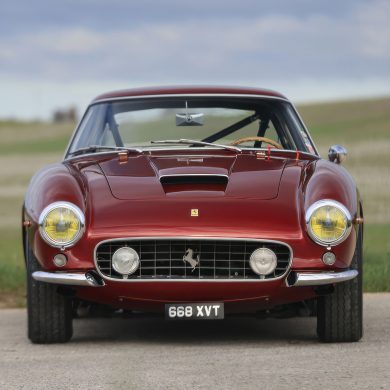
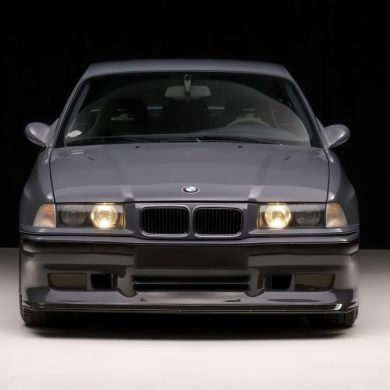

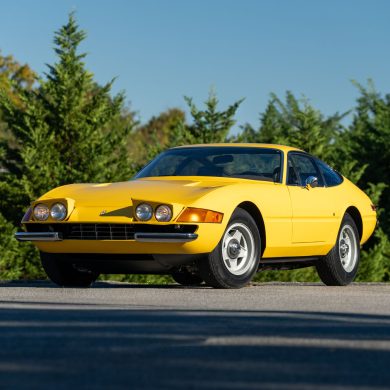
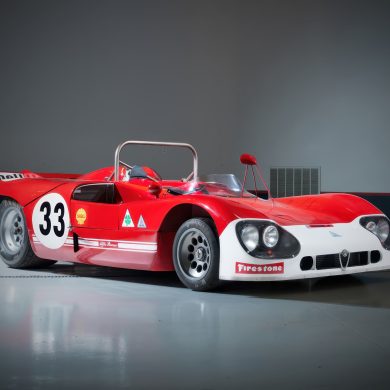
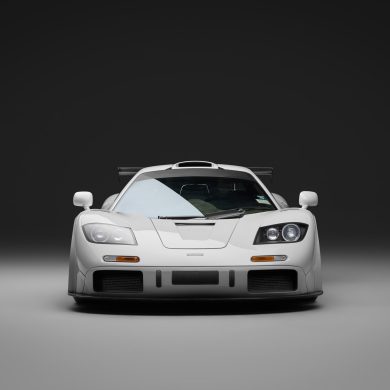


I need to hear the exhaust on this monster before I die.
Great article…!!!
The riding mechanic’s real name was Romeo Paciocco. He was my dad’s older brother.